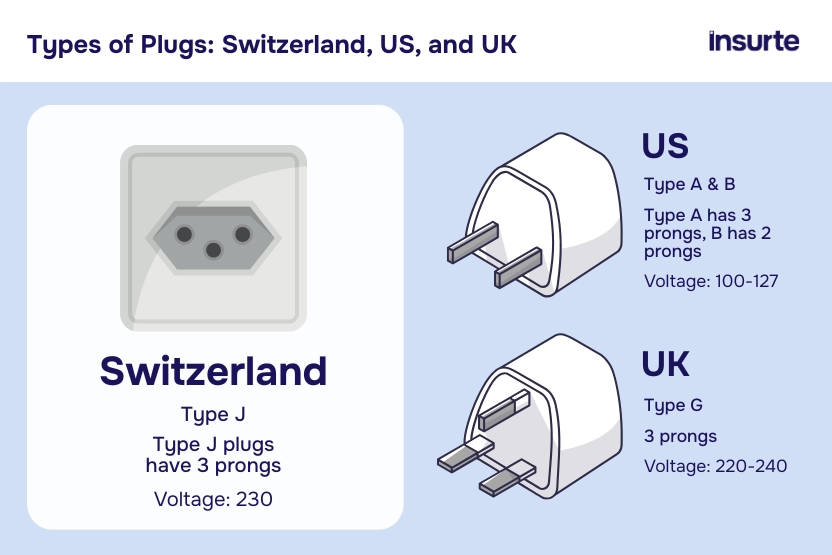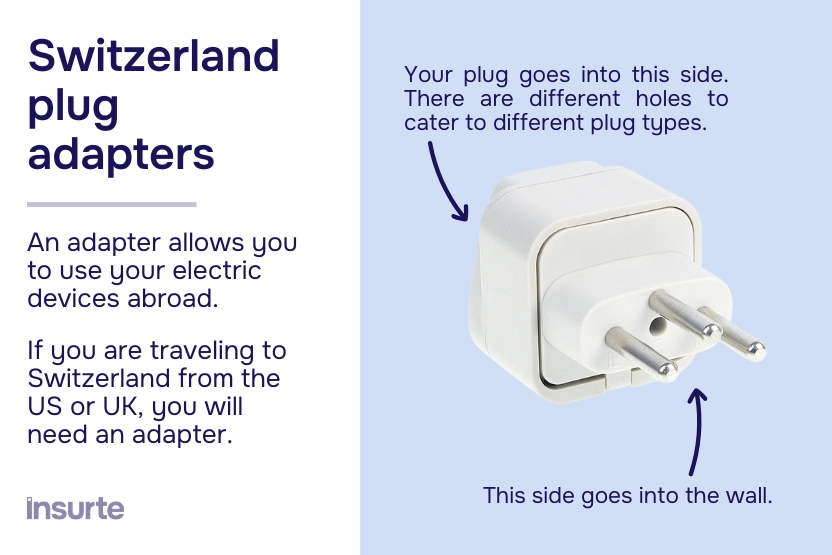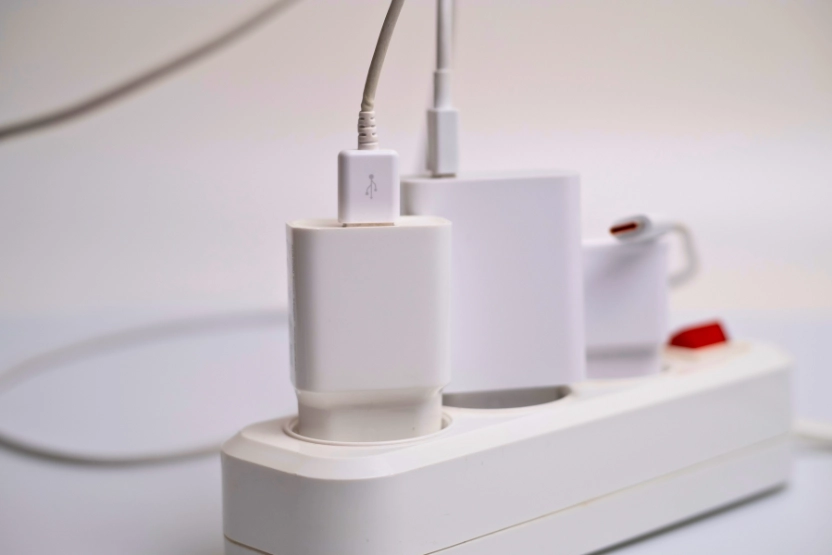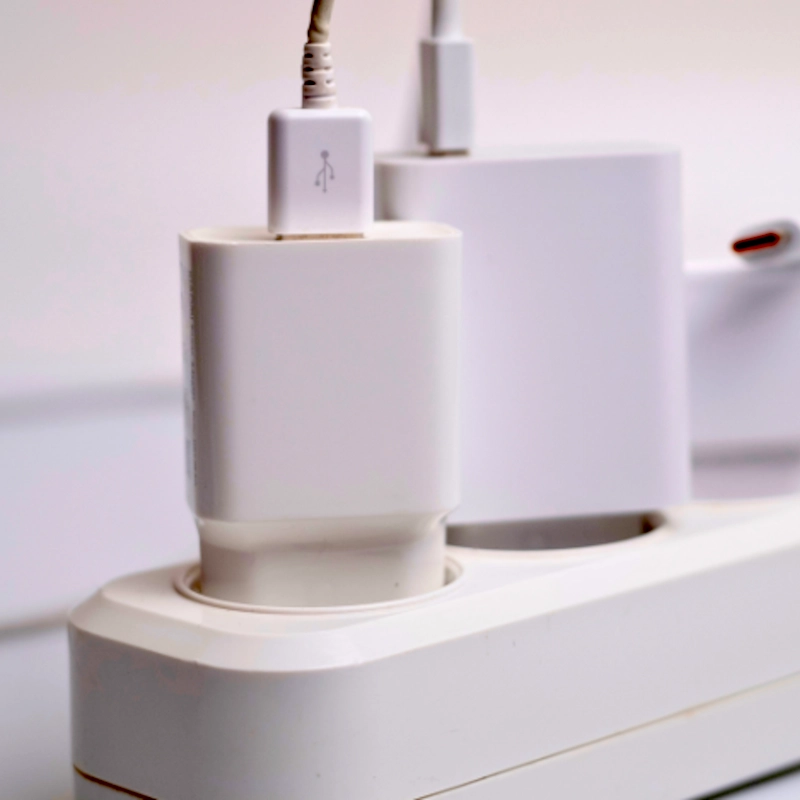Home > Travel Safety & Health > Switzerland Plug Types: What to Get in 2025
Share this post
When traveling to Switzerland, there are a lot of things to do to prep for your trip.
There are entry requirements to make sure you meet, accommodations and flights to secure, travel insurance to consider, and that doesn't even get into what to do or what to bring.
Well, there is one thing you want to make sure that you bring: And that's a travel adapter for Switzerland.
Different countries often have:
- Different electrical socket shapes.
- Different levels of voltage running through them.
Because of that, travelers need to make sure they have the right travel adapter in order to use/charge their electronics abroad.
On top of that, a converter (or transformer) might be needed too.
Don't worry, we're going to get into all of that in this guide to help you make sure you have everything you need to charge your electronics safely.

Plug types in Switzerland
Switzerland uses a Type J plug and electrical socket.
Type J plugs have three prongs (or pins as they're known in the electrical world).
The image above shows what the electrical sockets look like in Switzerland. As you can see, if you're coming from the US, UK, or many other countries, your electrical plugs aren't going to fit into Swiss sockets.
That's ok. That's why travel adapters were invented.
Travel adapters work as a link between your electrical plug and the local electrical socket.
You plug your electronic device (like a charging cable or blow dryer) into one end of the adapter, and the other end goes directly into the wall.

Which adapter you need
When traveling to Switzerland, you will need a travel adapter that has a Type J plug. The outlet needs to fit your country's plug type. If that's the US, it needs to have an input for Type A/B plugs. If that's the UK, it's Type G.
Now, if you have a travel adapter with a Type C plug (common in France and Spain), it will work in most plugs in Switzerland, depending on the size and shape of the adapter. Chunkier adapters may not fit, as the electrical sockets in Switzerland are typically narrow.
That said, there are sometimes larger ones. It just depends.
Where to get a travel adapter for Switzerland
Luckily, finding a travel adapter is very easy. As long as you make sure it has a Type J "output" and the outlet on it fits your plug, you're golden.
Many people buy travel adapters online and search things like "Switzerland travel adapter from US" or "travel adapter US to Switzerland". Just make sure you read the product page details and look at the images to make sure it will work for you.
You don't have to get a travel adapter online, however. Many department stores carry travel adapters in their travel sections (typically by the suitcases) or their electronics departments.
Worried about your belongings?
Get travel insurance with guarantees for lost or stolen luggage.
If you travel a lot, there are also universal travel adapters available that fit many types of inputs and have many different plug outputs in one. These can be really handy, but they are usually heavier and bulkier, which is something to think about.
It's also possible to get travel adapters at the airport, as well as in tourist neighborhoods once you arrive at your destination. Keep in mind that if you do that, you may pay a little bit extra for the convenience.

Switzerland's voltage and power converters
The first thing you need to think about is your travel adapter. The second is voltage. That isn't to say adapters are more important than power converters, however. Both play an important role in charging your devices abroad.
Oftentimes, different levels of voltage are used on different continents. When this is the case, power converters are needed. Power converters work similarly to travel adapters, but for volts, not plug shapes.
Switzerland runs on 230 volts, which is the same as its neighboring European countries like France and Germany, even Spain, Ireland, and the UK too.
That means if you're traveling from the UK, you don't have to worry about a power converter.
If you're traveling from North America, however, you will want to consider a power converter for your trip to Switzerland.

Why? The US runs on around 127 volts versus Switzerland's 230. This means that there is a stronger electrical current running through Switzerland's sockets.
Electronics are designed with specific levels of voltage in mind. If your electronic device was created for a lower voltage and you use it in a country with a higher voltage, it can ruin the device as the surge of electricity is too powerful. It also poses a fire risk, which nobody wants.
That said, some devices are designed to automatically work with different levels of voltage. Most newer phones and laptops, for example, don't need power converters since they're designed to work safely at both lower and higher levels of voltage.
Make sure you check your product type and manufacturer just in case, especially if your phone, tablet, or laptop or older or less common.
Many electronics aren't designed for dual voltage, though. Things like blow dryers, electric razors, curling irons, and small appliances are typically designed with a specific voltage in mind.
To use those devices safely in Switzerland, you want to consider a converter. Some travelers opt out of getting one and use their tools abroad anyway, but it isn't recommended, as it can ruin your belongings, and it poses a safety hazard.
FAQs: Switzerland travel adapters
Related posts
Upcoming travels ? Get Insured !
Find the right insurance for your trip by using our powerful comparison tool!
Sarah Pardi - December 12, 2025
Sarah Pardi - December 11, 2025
Sarah Pardi - December 4, 2025
Sarah Pardi - November 28, 2025





